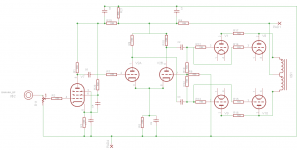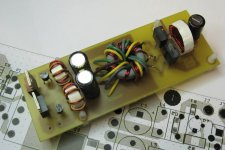I'm looking at doing a push-pull amp using 6S4S triodes and some Electra-Print output transformers. All of the circuits I've seen so far use cathode bias. Is theere any fundamental problem with using fixed bias if the bias source is low impedance? I was thinking of using source followers to drive the grids. I expect I'll get the usual snarky remarks about polluting the vacuum's precious bodily fluids with nasty silicon, but is there any real objection to using fixed bias with directly heated triodes? I'll be using some homebrew SMPS circuits to heat the filaments.
I would use them in PP with 350V on anode and -70V negative bias on grids, 15K P-P load. Should sound very nice.
Well, the original owner of the transformers intended them for a P-P 2A3 application. Right out of the RCA data sheet you get a set of design values that run the 2A3s at -60V fixed bias, 300V, 40 mA/side, about 140-150 ma peak current, 3k plate to plate load, 15W output. There we go... With the source followers I could go AB2 if I so wanted. A answered my own question, so it seems.
Maybe so, but I want to work with the transformers I have on hand, especially as I got the pair of Electra-Prints for 'prox 1/2 the price that Jack charges for one piece these days. My other option would be some 6k Fisher transformers (I seem to be awash in them these days, as I've been compusively grabbing Fisher tranformers on Fleabay).
The source follower is a very good idea. I am having great results in a 45's PP. The best driver so far....IMHO.
With those 3K OPT's I would suggest 250V/60mA, true 8 ohm speakers and it will be fine (will sound!! 😀). Using a classic 6SN7 cathode follower I remember I got "only" 14W at low THD. With the SF maybe it could be more (depending on how you make it....).
Cheers,
45
With those 3K OPT's I would suggest 250V/60mA, true 8 ohm speakers and it will be fine (will sound!! 😀). Using a classic 6SN7 cathode follower I remember I got "only" 14W at low THD. With the SF maybe it could be more (depending on how you make it....).
Cheers,
45
With 3K OPT you will probably get "That vintage sound" 😉
By the way, what are max grid current specs for either 2A3, or for 6С4С? It seems to me I have not seen them...
By the way, what are max grid current specs for either 2A3, or for 6С4С? It seems to me I have not seen them...
Seeing as I have some decent iron to work with, I might treat the amp to some Schade-style partial feedback, for that "not so vintage" sound....
Seeing as I have some decent iron to work with, I might treat the amp to some Schade-style partial feedback, for that "not so vintage" sound....
Sure, but 2A3 can sound pretty nice without any feedback.
I expect I'll get the usual snarky remarks about polluting the vacuum's precious bodily fluids with nasty silicon, but is there any real objection to using fixed bias with directly heated triodes?
I got a lot of grief when I first posted the PowerDrive concept on my web site about 5 years ago. Then little by little people built Tubelab SE's. Now that about 100 of tham have been built wih good reports, the PowerDrive concept doesn't seem too repulsive any more.
I'll be using some homebrew SMPS circuits to heat the filaments.
That one isn't too accepted yet. Probably because us mere mortals can't seem to make an SMPS that doesn't smoke or explode.
Take a look at the RCA data sheet for the 45. The little 45 is specified to give you 18 watts in P-P AB2 with a 3200 ohm load. I have tried it and it works quite well but wimpy tubes that play well in class A SE at 30 mA will cause flat top distortion when called upon to pass a 75 mA peak while the grid goes positive and draws current too. Only 5 of my 20 or so used 45's will work. Yes, I stuffed 2A3's into the same amp and they all work well and have no problem grunting out the power. About 25 watts flows forth when you torn the power supply up to 325V or so. A 6A3 is a 6 volt 2A3, and a 6B4 is an octal 6A3.
Attachments
I'm not certain that I want to "George" this amp. The Electra-Prints are specified at 15W, though they are larger than 20W Hammonds. Schade-style feedback sounds more and more to me like a good idea, lowering the output impedance of the 6S4S into those 3k transformers. What I'll do for a front end is up for grabs, as I won't be getting to this particular amp 'til I get 4 or so lower hanging projects out of the way. I may do a shootout between the Electra-Prints and a pair of output transformers of similar impedance made to work with PPP 6BQ5s (you know the ones I'm talking about, having donated one to the cause...). I originally intended to use the Baldwin transformers with the 6S4S until the Electra-Prints more or less fell into my lap.
I'm not certain that I want to "George" this amp.
That isn't what I was trying to say. If a pair of 45's are specified for operation at 18 watts into 3200 ohms, and a 2A3 is essentially a pair of 45's in parallel (the twin plate version anyway). They would be idling under the same conditions. Dialing the voltage up to 325 isn't Georgeing it. It is directly from the Tung Sol data sheet for the 6B4. In fact they list fixed bias, 325 volts on the plate 3000 ohm load, 15 watts out in A1 with 2.5% distortion.
I would start there, and then being George I would go to say 360 volts and the drive the grid until the distortion takes off. I have ran 2A3's at 360 volts in a SE amp, so I assume it would woek in P-P, but I haven't tried it yet.
When all is said and done, I'll end up doing what the output transformers say I can do, whether or not the tubes happen to be liking their situation. I think I'll bug Jack at Electra-Print and see if he'll divulge any of the design assumptions behind this build. The inductance is ok for the output impedance (59H at 50V, 300 Hz excitation). Maybe I should take them back in to work and test the leakage as well - that would make an interesting comparison with the Baldwins. The Baldwin transformer I measured (similar stack size and impedance) has 90H of primary inductance - maybe Jack stuck a little bit of a gap in so that the transformer would better tolerate mismatch between tubes. I'll have to ask. The E-Ps have been sitting around for a while, as they're slightly rusty. Some wirebrushing and engine enamel will tart them up to my satisfaction. Favorite XFMR color - metallic cast iron gray - classy, and goes with a lot of chassis colors.
P.S. - The Russian 6S4S are reputed to be capable of higher B+ than the average 6B4G - maybe I'll take advantage of that. One thing I know for sure - they're certainly a lot cheaper that your average 2A3/6B4G.
P.S. - The Russian 6S4S are reputed to be capable of higher B+ than the average 6B4G - maybe I'll take advantage of that. One thing I know for sure - they're certainly a lot cheaper that your average 2A3/6B4G.
Last edited:
Here is something
I pulled this from a book I found on Pete Millett's book library. It was made for a 6B4Gs and it asked for a 2.5k or 3k opt. It would likely need minor tweaking, I also did this copy in about 15 min. so there may be errors. The other tubes were a 6SJ7 ans 6SN7. This one is for next summer 🙂
I pulled this from a book I found on Pete Millett's book library. It was made for a 6B4Gs and it asked for a 2.5k or 3k opt. It would likely need minor tweaking, I also did this copy in about 15 min. so there may be errors. The other tubes were a 6SJ7 ans 6SN7. This one is for next summer 🙂
Attachments
Last edited:
With 3K OPT you will probably get "That vintage sound" 😉
By the way, what are max grid current specs for either 2A3, or for 6С4С? It seems to me I have not seen them...
Not at all Wavebourn, actually you get a vintage sound if you employ self bias and AB1 operation with that 3K OPT!
The low Zout direct coupled driver makes a huge difference in my experience. Having used high quality expensive IT transformers with low impedance tubes (like 45's and 6H30P-DR to drive 45's!) the MOSFET is the winner for me. The purists can believe what they want....
The speakers are important in the sense that having a Zout close to speakers impedance you have to be careful about the correct alignment for the bass driver if reflex or the right Q if sealed. I would prefer the latter in this case...just like the old good Snell K.
I don't know the actual grid current specs for the 2A3 but they don't seem to be too much different from the those of the 45. For the above mentioned 14W amp I used a +/-170V and 15K load for the 6SN7 CF resulting in approx. 8.5 mA current. It was perfectly sufficient for the job.
Cheers,
45
Last edited:
I pulled this from a book I found on Pete Millett's book library. It was made for a 6B4Gs and it asked for a 2.5k or 3k opt. It would likely need minor tweaking, I also did this copy in about 15 min. so there may be errors. The other tubes were a 6SJ7 ans 6SN7. This one is for next summer 🙂
It's a parallel PP. So 5-6K load per pair. However I repeat that it is more important to match the amp with right speakers regardless of the primary load because the Zout will not be so much lower.
Cheers,
45
Here's the first stab at an isolated switching heater supply for DHTs. This is a little guy tailored for the requirements of the 6B4G/6S4S. One board does for two tubes, so I'll need a pair for a stereo amp. It's designed to run off a central regulated supply (+15V for now), and consists of a simple choke-fed push-pull chopper with two Schottky rectified outputs. Each output has a simple ring-of-two current regulator set for the 1A filament requirement. Seeing as people usually run these tubes with a transformer that puts out whatever the AC line happens to be delivering at the time, by comparison this circuit will be treating the filaments with kid gloves. It'll allow me to eventually run the amp from a single central SMPS without a lot of extra complications. Oh, yeah, there will be some heat sinks added down the line, at least for the Darlingtons in the current regulators. The mosfets at the front end probably won't need anything to speak of.
Attachments
Last edited:
- Status
- Not open for further replies.
- Home
- Amplifiers
- Tubes / Valves
- 6B4G / 6S4S Biasing Question


